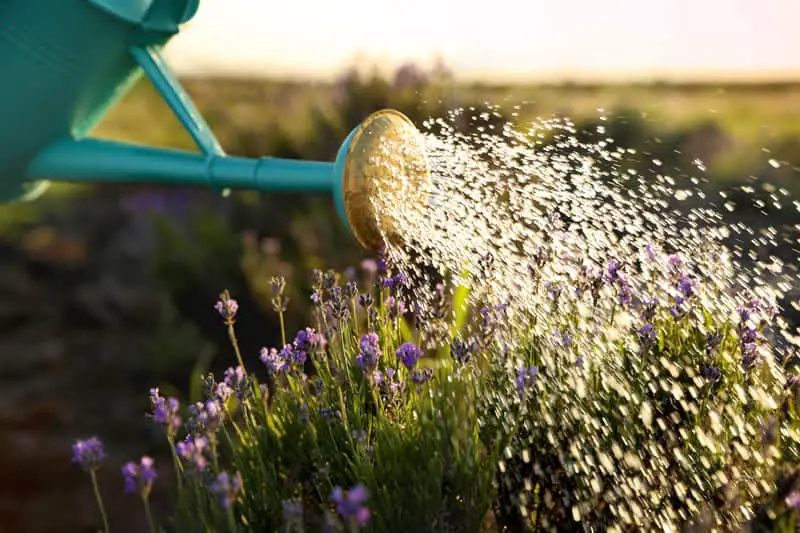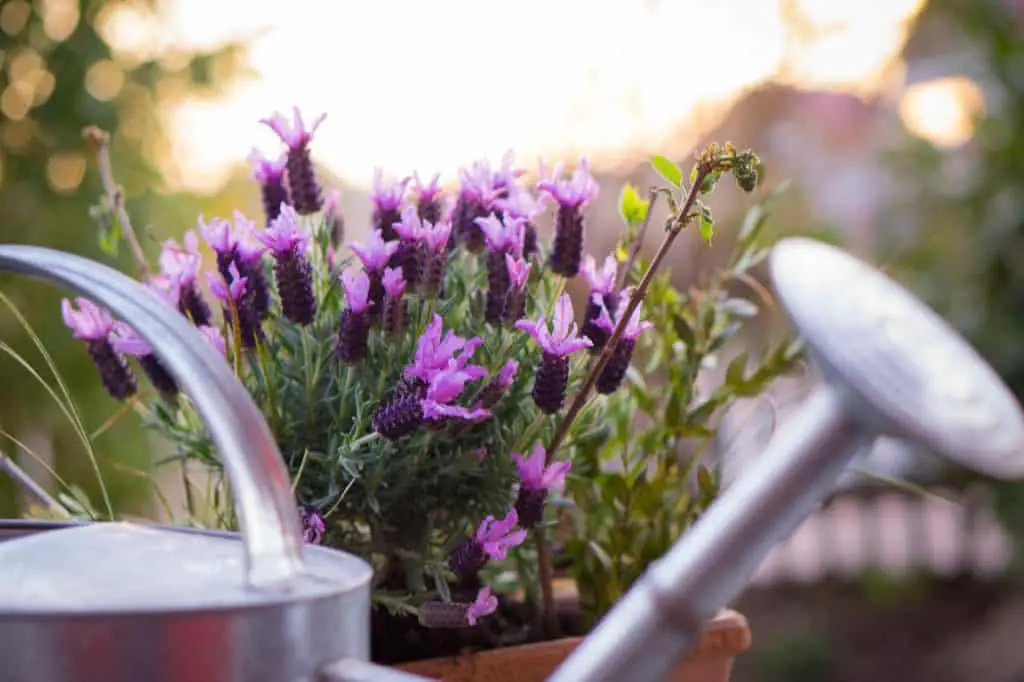Lavender is native to the hilly, Mediterranean coast and its gorgeous smell wafts into the air on a hillside walk there, alongside other herbs such as thyme, rosemary and oregano.
The climate is very hot in summer, so these aromatic plants are used to receiving direct sunlight outdoors but they are used to not being watered every day.
Indoors, you only need to water your lavender plant infrequently, when the topsoil of the soil in the pot feels dry. Read on for more tips on keeping your Lavender plant healthy.
How often should I water lavender?
It is certainly true that lavender enjoys infrequent watering and it prefers its surrounding soil to become dry to the touch before you water again. That said, it does not like when the pot dries out completely either so check with your finger or a pencil, to see if the soil a little deeper down is moist. If not, that’s a good time to water.
How often do I need to water my Lavender plant in summer?
Outdoors Lavender plants grown in the ground are very tolerant of dry weather.
An exception to this rule is newly planted Lavender plants.
These need to be watered more in their first year outdoors, water them in generously and keep your eye on them. If there has been no rainfall for an extended period and your plant looks limp, then by all means get out your watering can.
Outdoor Lavender plants in pots. The roots of pot plants are confined to whatever moisture is available in the soil, so check these plants more regularly, by feeling moisture levels in topsoil on the surface and also a little deeper.
If you cannot feel moisture at all, then give your Lavender plant a good watering and wait until this dries out before watering again.
Indoor Lavender plants in pots will value a sunny balcony, patio or window sill, if you can provide one. Direct sunlight is the best tonic for any lavender plant! Indoor potted plants definitely need watching and will crave some more water in summer, if temperatures are hot outside.
With regular water and a monthly feed, they will reward you with fragrant blooms in tall spikes of purple or lilac colors in July and August. See FAQs below.
How much water do you need to give a Lavender tree?
What a Lavender tree needs most is good, warm direct sunlight so the main advice about watering is to get the location of your plant sorted first. A newly potted Lavender tree needs regular watering only in its first year of growth.
After that, always allow the topsoil to completely dry out and when you touch the soil a little further down, if that feels dry then give it a good soaking.
Lavender is not enamoured with feeding. Remember it lives on dusty, dry mountainy soil out in the wild. If you water very frequently, this Lavender tree is likely to suffer from root rot. To avoid this, water as directed above and see how to deal with root rot in FAQs below.
What happens if you overwater lavender?
Lavender is not a plant that takes kindly to being overwatered.
In the wild, it gets the odd rainstorm and survives on that. In your home, check the soil at the top of the pot.
If that is dry, check a little deeper with your finger. If that feels dry, only then water.
If you water these plants excessively the most likely outcome is root rot for your lavender plant. See more details below if you suspect this to be the case for your Lavender plant.
How do you keep lavender alive?
It is important to remember that the life cycle of a Lavender plant is not forever. With good natural sunlight and regular pruning, your plant may last about 15-20 years.
You can turn around your plant so that all sides of the pot get equal sunshine and this will also avoid the branch spread that occurs frequently with lavender plants.
Keep the temperature between 50-65 degrees Fahrenheit in the summer growing period and slightly cooler during the winter.
I also advise you to put all indoor lavender plants outdoors in summer, if you can.
However, older plants tend to get woody, with thick stems and the plant appears to spread. If you have traveled to the Mediterranean, you may have noticed plants that look as if they need support.
The older your plant is, the more you need to prune it, to avoid this happening. See FAQs below for how to prune.
Some more tender Lavender plants may only last 5 years or so and even less, if you overwater them. See what can go wrong with lavender below.
FAQs
What can go wrong with Lavender?
The plant spreads and sprawls and becomes woody. This lavender bush needs good pruning. See how to do this in TIPS.
It does not have a neat, bush shape. Again, the answer here is good pruning and removing any branches that do not add to a pleasing shape. See below.
Root rot is common in pot lavender plants because many people overwater them. If your whole lavender plant is wilting, and if the leaves are turning yellow or brown, these are the warning signs of root rot. Sometimes the whole plant stops growing completely.
- Check the roots carefully. First, wash the roots completely in freshwater.
- Then remove any damaged-looking roots with secateurs, ensuring that you wipe or sterilize after each cut to avoid spreading the rot.
- Then dry out the plant in the air and replace all the compost with new soil.
- Keep a close eye on your plant from now on.
After this, whenever you feel tempted to pour a watering can over this plant, think of dry dusty Mediterranean hills and take your time! Check the soil is dry and if it lacks moisture, then water.
What is the best way to prune Lavender?
Frequently! English lavender flowers from May onwards and if you prune it right after its first flowering, your Lavender plant may surprise you with a second flowering later in the summer.
The plant quickly grows into odd shapes with curling stems, so remember that when pruning and try to make a neat, bush shape if that’s the effect you are after.
As you cut, you can also collect flowers to make lavender bags or pillows and to make your own Lavender oil. Read on to see what to do with the cuttings.
Waste not, want not! You can use cuttings from pruning to propagate new plants. Just dip the cut ends in hormone rooting powder and put the stakes into a pot of fresh compost. Water in well and wait a month or so to check root growth. Then pot these on when the plant reaches a bigger size.


